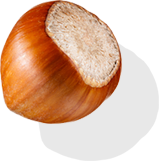Because of their constant availability, nut season makes less of a seasonal impact than it once did. But in Italy, there is still a palpable association between autumn and the nut harvest, when we can enjoy them at their peak. A piece of fruit and a few cracked nuts - hazelnuts, almonds, and particularly walnuts - is still a normal part of closing a meal, and the tabletalk revolves around the merits of this year’s harvest to last year’s.
The world’s leading producer of hazelnuts is Turkey, although the Italians, in second place, claim to have higher quality cultivars. Lazio (specifically Viterbo) is home to the Tonda Gentile Romana, which bears the coveted PDO certification - ‘Protected designation of origin.’ They produce the lion’s share of Italy’s hazelnuts, followed by the region of Campania with Nocciola Giffoni PGI - ‘Protected geographical indication’ certified. Piedmont arguably produces the most prized cultivar, the PGI Tonda Gentile delle Langhe, from the hazelnut groves located on a UNESCO World Heritage Site. Attempts to transplant them in California failed to produce nuts with the same outstanding characteristics and quality, a case in point for terroir advocates.
Gianduja
Before there was Nutella, there was crema di gianduia. Torinese gianduja (or gianduia) is the felicitous result of creaming hazelnuts and chocolate together, but its mythic origin is mired in political strife.
In the tempest of Napoleon’s ambitions, tariffs on cacao tripled between 1802-1805. After he had established the Continental Blockade, which effectively cut off trade with Britain and brought the conduits of cacao trade under his control, prices soared twenty times from what they had been previously. In this scenario, it is important to recall that the region of Piedmont had been annexed by France in 1802. Eventually, Turin would become the first capital of the Kingdom of Italy, but that would not happen for another fifty-nine years.
The embargo very neatly sets up a scarcity/necessity meme, one of zillions that pock mark culinary history. It would have us imagine some desperate, albeit enterprising, chocolatier(s) labouring to find a way to extend the wee bit of costly cacao that could be had, with available local ingredients (enter the Tonda Gentile delle Langhe). The absence of credible primary source documentation, compounded by the successful passage of a jumble of incongruent mythemes into factoids amidst a tangle of anachronistic fusions, have made it nearly impossible to reconstruct a coherent, fact-based origin story - but that is mercifully irrelevant to the success of the recipe below.
Gioan d’la doja
Although the coupling of chocolate and hazelnuts may not have been the Torinese eureka moment that they would make it out to be, the name gianduja is unmistakably local. It derives from a “mask” or a commedia dell’arte -style stock character called Gioan d’la doja, specifically tied to Turin, which essentially translates into ‘John of the tankard.’
John is a 19th century creation of a simple, jovial lech with a weakness for women and wine. He was a beloved figure at Carnival time in Turin, and indeed, king of their revels. He is always depicted dressed in a tricorn with a gaudy yellow waistcoat and a glaringly red-trimmed jacket. But how is it that the chocolates took his name?
The character who came to be called simply ‘Gianduia’ was a very important vehicle in satirical political commentary during the Risorgimento. Unification leader Cavour even referred to Piedmont wholesale as Gianduia. Therefore, when the actor playing the stock character at the 1867 Carnival in Turin tried the creamy chocolates and formally gave his permission in writing for the confection to assume the character name gianduia, it was a weighty gesture. However, this piece of ‘history’ does not surface until the reformulation of the company in the 1930s, and the certification has never been produced. But the claim remains testimony to the sway of influence wielded by the figure.
At the end of WWII, when Ferrero (makers of Nutella) picked John up as the representative of their products, they cleaned up his act a bit - at the very least, dispensing with those fake beauty marks.
While Nutella is the best known brand of chocolate-hazelnut spreads, there are many in Italy. In my opinion, Pernigotti dark chocolate is among the best, and certainly the best suited to my original recipe for Gianduia cake. But once you have told your guests you’ve made them a cake with Nutella, the hairsplitting details will be superfluous.
Make a point of picking up a jar of the Pernigotti next time you are in Italy.
Gianduia cake - a ‘better next day’ cake
Ingredients:
150 g 70% dark chocolate
150 g sugar
1/4 tsp salt
200 g toasted hazelnuts
25 g self-rising flour (or 3 tbsp flour and 1/4 tsp baking powder)
80 g softened butter
70 g Pernigotti gianduia/ Nutella
5 eggs separated
1 tsp real vanilla essence
Raw materials
Instructions:
Preheat oven to 180C°; butter an 8” springform pan
Chop the chocolate and melt. Set aside to cool.
Put the hazelnuts in a processor and add a couple tablespoons of sugar, the flour and the salt and grind to a powder.
Cream the butter, add the rest of the sugar, the gianduia cream/nutella, and then add the yolks one by one. Stir in the vanilla.
Whip the egg whites to soft peaks in a large bowl then fold in the chocolate, the nut mixture, add the butter/yolk mixture.
Pour into a well-buttered 8 inch springform pan and bake 40 min or until tester comes out clean.
Let cool; eat the next day when the moisture and oils have had time to redistribute.
Secondary preparation of ingredients
Everything mixed together
Top with powdered sugar just to make it look pretty. Better the next day.












